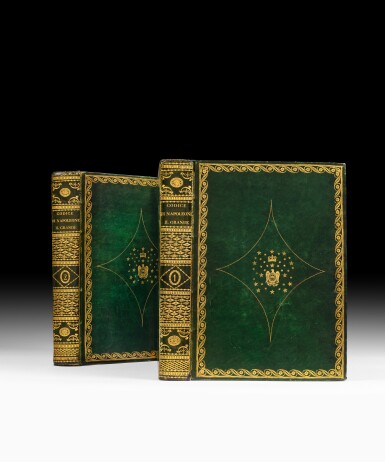
[Beauharnais, Eugène de]
Codice di Napoleone il Grande pel Regno d'Italia. Milan, dalla Reale Stamperia, 1806. Exemplaire aux armes d'Eugène de Beauharnais.
Auction Closed
June 25, 05:03 PM GMT
Estimate
50,000 - 80,000 EUR
Lot Details
Description
[Eugène de Beauharnais]
Codice di Napoleone il Grande pel Regno d'Italia. Edizione originale e la sola ufficiale.
Milan, dalla Reale Stamperia, 1806.
2 4to volumes (345 x 248 mm). Green straight-grain morocco, wide gilt floral roulette border, gilt arms in the center of the sides, smooth spine richly decorated with gilt tools, inner roulette, gilt edges (Contemporary binding).
First Italian edition of Napoleon’s Civil Code.
One of the few gift copies printed on large paper, very elegant binding for Eugène de Beauharnais, Viceroy of Italy.
First Italian edition printed under the direction if L. Nardine, director of the royal printing house.
Copy on large vellum.
Text in two columns in Italian and French
A portrait of Napoléon drawn and engraved by J. Ph. Longhi placed as a frontispiece and a table at the end showing the distances between Milan and each departmental capital ("Tavola delle distanze da Milano a tutti i Capo-luoghi dei Dipartimenti regolate col ragguaglio del miriametro al miglio italiano).
On March 21, 1804, two months before the proclamation of the Empire, the Civil Code was promulgated. Napoléon proclaimed himself King of Italy in Milan on March l7, 1805, and donned the Iron crown of the Lombard kings. On June 7, he entrusted the vice-royalty to Eugène de Beauharnais. The Civil Code entered into force in the kingdom of Italy on April 1, 1806 and was then quickly translated into Italian and published under the title Codice di Napoleone il Grande pel Regno d’Italia. It was also under the title of Code Napoléon that the second French edition was published in 1807.
After the fall of the Empire, the Civil Code spread across Europe and would inspire the drafters of many national civil legislations.
"The Civil Code has accompanied the history of Italian civil law since 1806, at which time the Italian version of the Code was published in Milan under the title Civil Code of the Kingdom of Italy. This code served as the model for pre-unification Italy’s Civil Code of 1865 of unified Italy and still represents a reference point for the Italian culture of the twentieth century, during which an attempt at a Franco-Italian code was made. Even after the code of 1942, the French Civil Code and French legal code are still considered as models and irreplaceable interlocuters" (Alpa Guido, "Le Code civil et l’Italie, Revue internationale de droit comparé, vol. 57, n° 3, 2005. p. 571-625).
The unsigned binding was very likely made by Luigi Lodigiani, bookbinder to the imperial court of Milan.
Eugène de Beauharnais (coat of arms; does not appear in the "Bibliothèque Eugène de Beauharnais. Bibliothèque des Ducs de Leuchtenberg" sale, Zurich, May 23-24, 1935).
Olivier, Hermal and Roton, Manuel de l’amateur de reliure armoriées françaises, Paris, 1934, pl. 2671 (for a similar tool).
